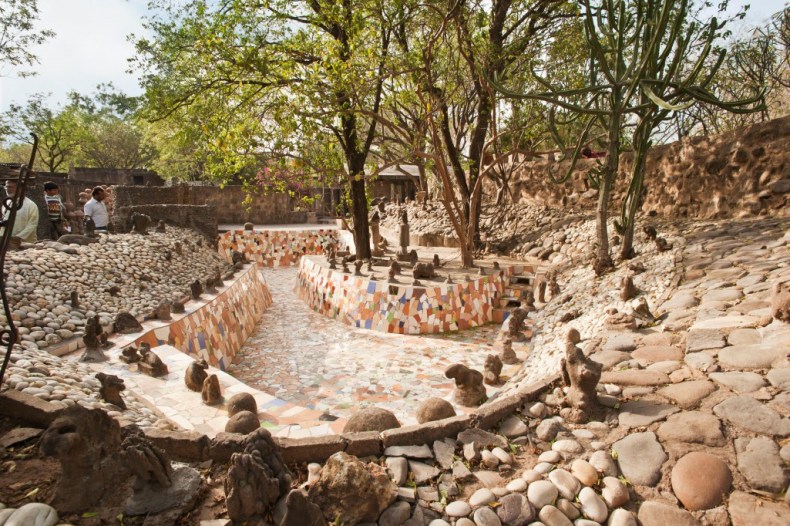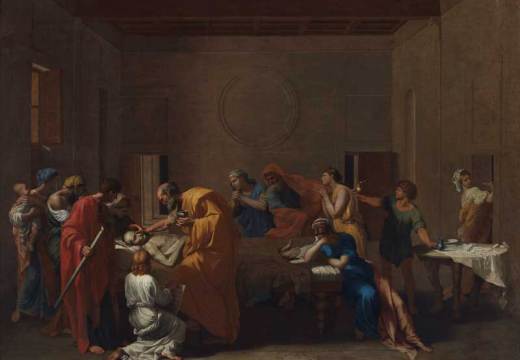Chandigarh, the new capital of the Punjab proposed by Jawaharlal Nehru after Indian independence, is laid out on a grid plan, with wide streets for road traffic separating carefully planned residential and commercial sectors. The concept is rational and open – and Western. But tucked away close to the famous government buildings designed by Le Corbusier is an extraordinary realisation of a very different idea of architectural space. Reached through low arches cut into a wall made of concrete and tar drums is the Rock Garden – made not of rocks, but of poured concrete, broken pots, plates and ceramics, stones, redundant ceramic electrical fittings, tiles, glass bangles and other waste products or objets trouvés. At first, the spaces enclosed by rough, undulating concrete walls are small, peopled with strange ceramic figures and little temples. But narrow passages lead to further unexpected spaces, and then more and more, with cascades and waterfalls, and other surprises.
This Rock Garden was designed by Nek Chand, an untaught, or self-taught artist who died last year at the age of 90. His creation in Chandigarh is a supreme example of ‘Outsider Art’. It is best compared with those other examples of monumental naive architecture, such as the Watts Towers in Los Angeles – made by the Italian immigrant builder, Simon Rodia, out of concrete, wire mesh, porcelain and scrap metal – and Le Palais idéal at Hauterives in France, an exotic fantasy built out of stones and cement by Ferdinand Cheval, a postman. In each case the artist pursued his vision with obsessive single-mindedness; in each case the result baffled and annoyed, and was threatened with destruction. Indeed, the survival of Chand’s introverted world within the somewhat arid, modernist environment of Le Corbusier’s new city seems little short of miraculous.
Chand was born around 50 miles north of Lahore, in what is now Pakistan. For him, as for millions of others, the hurried, botched partition of the former British India in 1947 was a profound trauma. His Hindu family had to leave their home and flee to the Indian side of the new border. His Rock Garden seems to have been an evocation of a lost childhood, a realisation of the stories his mother had told him of kings and queens in a beautiful realm; his fantasy was a ‘Devtaon ki Nagri’, a kingdom of gods and goddesses. But first he needed a job. In 1951, Chand was appointed a road inspector with the Public Works Department (PWD), charged with supervising the construction of roads. And in this capacity he began to see the potential of waste products. As a guide to the Rock Garden puts it, ‘On every holiday, he ignored domestic liabilities and instead of spending time with family, he used to bicycle to river beds, mountains, jungles in search of his “treasure”.’

The Rock Garden is built out of concrete and objets trouvés. Photo: © ImageDB/Alamy Stock Photo
At first Chand assembled his material in the PWD store he supervised. Then, in about 1965, he began to build, secretly and often at night. There was never a plan: the shapes, the features, the spaces evolved bit by bit as his fertile imagination developed. Then, in 1973, came the inevitable crisis. After the construction of the adjacent road, the PWD store was meant to be removed and the land left as forest. Suddenly, the administration of Chandigarh discovered the Rock Garden. Why it took them so long to notice it when it is just a few hundred yards from Le Corbusier’s Palace of Justice, or High Court building, is a mystery. But what is certain is that the bureaucratic process was thwarted. M.N. Sharma, Chandigarh’s first Indian chief architect, visited and was entranced. The Rock Garden was saved and, three years later, it was opened to the public. Chand was relieved of his ‘mundane duties’ and given money to devote all his time to continuing to build.
The Rock Garden became hugely popular – it is said that in India only the Taj Mahal attracts more visitors. But, in its rigid mediocrity, the bureaucratic mind cannot tolerate such individualistic fantasies. In 1988, the High Court applied for permission to remove part of the garden to make way for a ‘Botanic Park’ linking the lawyers’ car park with the Sukhna Lake. The Bar Association argued that the expansion of the Rock Garden violated the masterplan of the city and encroached on land earmarked for the High Court. A popular outcry and a court hearing resulted in the withdrawal of its petition, but still Chand’s detractors did not give up. The following year it was proposed to cut an approach road to a nearby village through the Rock Garden, and only a ‘human shield’ stopped the bulldozers. Chand then suffered a severe heart attack. And the jealousy and malice continued. Despite its popular success and international interest, in 1996 – when the artist was away in the United States – staff and funding were withdrawn, and the place was vandalised. So the following year the Nek Chand Foundation was set up to maintain and continue the Rock Garden.
To visit the Rock Garden today is to follow the development and expansion of an organic vision that unfolded over several decades. The first, secret phase is small and intimate in scale. Phase II, completed in 1983 with public support, was more ambitious, with a valley with a waterfall topped by ceramic temples and trees and tendrils formed of concrete. Phase III, begun in 1993, with intermittent official support, was even more ambitious and spacious. There is another enchanting valley with high walls, a waterfall and temples, and phalanxes of modelled figures – men, women, birds, bears, dogs, dragons – culminating in a wide open space where there are multicoloured ceramic walls and big rough concrete arches. This area is vaguely reminiscent of Antoni Gaudí’s Park Güell in Barcelona, except that here the arches support ‘great swings’ and are topped by a line of white horses, faced in white-glazed broken fragments.
Nek Chand’s Rock Garden is pure enchantment, a witty, allusive fantasy in three dimensions. But what would Le Corbusier have made of it? Its intimate, complex, irrational spaces are the complete antithesis of the nearby Capitol, where his monumental concrete buildings stand in isolation on a vast open space. But Le Corbusier was not always the posturing ideologue who had extolled ‘an ordered system of straight lines and right angles’ and condemned the curve, seeing haphazard nature as the enemy which ‘all around thwarts us’. For when he was invited to plan Chandigarh he was already building his pilgrimage church at Ronchamp, with its symbolic shapes and irrational curves that so upset blinkered British modernists. I would like to think he might have seen the point of the creation of another obsessive individualist, and he would surely have been impressed by a most inventive demonstration of what can be done with concrete.
From the April issue of Apollo: preview and subscribe here.
Unlimited access from just $16 every 3 months
Subscribe to get unlimited and exclusive access to the top art stories, interviews and exhibition reviews.














![Masterpiece [Re]discovery 2022. Photo: Ben Fisher Photography, courtesy of Masterpiece London](http://www.apollo-magazine.com/wp-content/uploads/2022/07/MPL2022_4263.jpg)
Has the Fitzwilliam lost the hang of things?